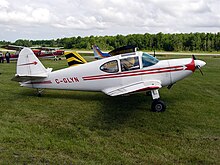Globe GC-1 Swift: Difference between revisions
m Robot - Speedily moving category Low wing aircraft to Category:Low-wing aircraft per CFDS. |
|||
| Line 183: | Line 183: | ||
[[Category:United States civil utility aircraft 1940–1949]] |
[[Category:United States civil utility aircraft 1940–1949]] |
||
[[Category:Propeller aircraft]] |
|||
[[Category:Low-wing aircraft]] |
[[Category:Low-wing aircraft]] |
||
[[Category:Single- |
[[Category:Single-engined tractor aircraft]] |
||
[[Category:Globe aircraft|Swift]] |
[[Category:Globe aircraft|Swift]] |
||
[[Category:Temco aircraft|Swift]] |
[[Category:Temco aircraft|Swift]] |
||
Revision as of 00:25, 16 April 2013
| Swift | |
|---|---|

| |
| Globe Swift | |
| Role | Civil aircraft |
| Manufacturer | Globe Aircraft/TEMCO |
| Designer | R.S. Johnson |
| First flight | GC-1A Swift: 1942 |
| Introduction | 1946 |
| Number built | 1,521 (including prototypes)[1] |
| Developed from | Culver Cadet |
| Developed into | T-35 Buckaroo |




The Globe Swift, also known as the Globe/Temco Swift, is a light, two-seat sport monoplane from the post-World War II period.
Design and development
The Swift was designed by R.S. "Pop" Johnson in 1940, despite the fanciful story which has now entered into popular mythology surrounding the Swift's origins, that a Culver Cadet was obtained as a "template" aircraft.[2] The design was financially secured by John Kennedy, president of the Globe Medicine Company, to be built by his new Globe Aircraft Company. World War II interrupted their plans, however, and the 85 hp (63 kW) GC-1A Swift advertised as the "All Metal Swift" re-designed by K.H."Bud" Knox, received its type certificate on 7 May 1946. Two prototypes were built but essentially, the design remained the same as the type entered production.[3] Globe built about 408 GC-1As.
Later that year, the Swift received a more powerful engine of 125 hp (93 kW), making it the GC-1B. Globe, together with TEMCO, built 833 GC-1Bs in six months. Globe was outpacing sales of the Swift, however, and did not have enough orders to sell all of the aircraft being built. As a result Globe was forced into insolvency. TEMCO being the largest debtor paid $328,000 to obtain the type certificate, tooling, aircraft, and parts to enable them to continue production in late 1947, in the hope that reviving production would enable TEMCO to recover their loss.[4] TEMCO went on to build 260 more aircraft before shutting Swift production down permanently in 1951.
The type certificate for the Swift was obtained by Universal Aircraft Industries (later Univair) along with all production tooling. Spare parts continued to be built until 1979 when the Swift Association under the leadership of President Charlie Nelson was approached to take over the operation.[1]
Operational history
The Globe/TEMCO Swift has seen many modifications. The Swift was originally powered by a C-85 85 hp (63 kW) engine driving a Beech Roby wooden propeller. Within a year the engine was upgraded to a C-125, again turning an Aeromatic propeller. Performance had been marginal with 85 hp (63 kW), and only moderate with 125 hp (93 kW), so many owners have installed more powerful engines, from 145 to 210 hp (108 to 157 kW). [citation needed]
The most unusual variant of the series became a separate design, the TEMCO TE-1 Buckaroo which was built in a short-run first as a contender for a USAF trainer aircraft contract, and was later transferred to foreign service as a military trainer.[5] Several of these trainers have since returned to the civil market.
Specifications (GC-1B)
Data from Flugzeuginfo.net[6] Type Certificate Data Sheet No. A-766 [7] & The Incomplete Guide to Airfoil Usage[8]
General characteristics
- Crew: one
- Capacity: one passenger
- Length: 20 ft 10 in (6.35 m)
- Wingspan: 29 ft 4 in (8.94 m)
- Height: 6 ft 2 in (1.88 m)
- Wing area: 132 sq ft (12.3 m2)
- Airfoil: Root NACA 23015, Tip NACA 23009
- Empty weight: 1,370 lb (621 kg)
- Gross weight: 1,710 lb (776 kg)
- Powerplant: 1 × Continental C-125 six cylinder, four-stroke aircraft engine, 125 hp (93 kW)
Performance
- Cruise speed: 122 kn (140 mph, 226 km/h)
- Never exceed speed: 161 kn (185 mph, 298 km/h)
- Range: 1,000 nmi (1,200 mi, 1,900 km)
- Service ceiling: 18,000 ft (5,500 m)
- Rate of climb: 700 ft/min (3.6 m/s)
See also
Aircraft of comparable role, configuration, and era
References
- Notes
- ^ a b Davisson 1983, p. 71.
- ^ Davisson 1983, p. 67.
- ^ Davisson 1983, p. 69.
- ^ Aviation News volume 7. 1947.
{{cite journal}}: Missing or empty|title=(help) - ^ Davisson 1983, p. 70.
- ^ "GC-1 Swift." flugzeuginfo.net. Retrieved: April 17, 2010.
- ^ "Type Certificate Data Sheet No. A-766." airweb.faa.gov. Retrieved: April 17, 2010.
- ^ Lednicer, David. "The Incomplete Guide to Airfoil Usage." ae.uiuc.edu, October 2007. Retrieved: April 17, 2010.
- Bibliography
- Davisson, Budd. "Swiftly, Swiftly: An Appreciation of one of General Aviation's Classic Aircraft." Air Progress, Vol. 45, No. 8, August 1983.
- Lert, Peter. "In The Air: Used Singles Guide." Air Progress, Vol. 48, No. 7, July 1986.
